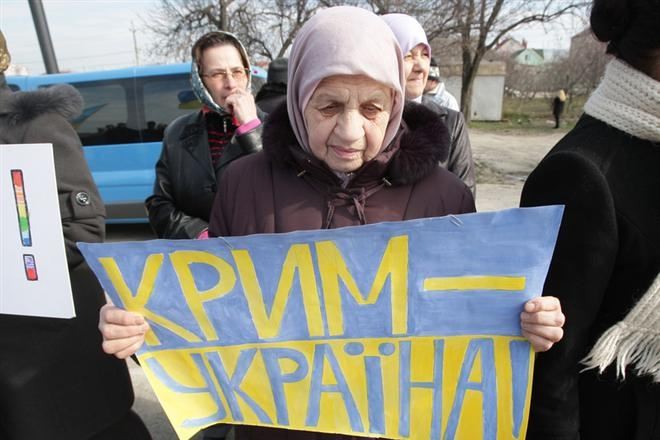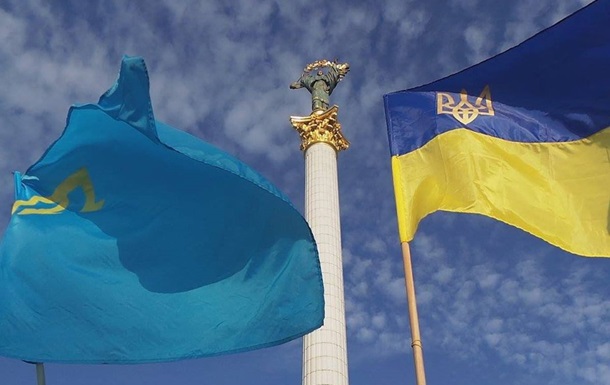Crimean student refuses to 'repent' for the Ukrainian and Crimean Tatar flags and the words Crimea is Ukraine

Elnaz Charukhova, a third-year law student, was recently convicted by an occupation ‘court’ in Simferopol of ‘discrediting Russia’s armed forces’ for a social media post with the Ukrainian and Crimean Tatar flags, and the words ‘Crimea is Ukraine”. After three years of similar charges for as little as playing the Ukrainian national anthem, this new prosecution might have gone unnoticed were it not for one key difference. The young woman refused to make the videoed ‘apology’ that has become part of Russia’s terrorization of the population on occupied territory.

Crimean Realities has established more details about this prosecution with the ‘court’ hearing taking place in June 2025 before ‘judge’ Galina Aleksandrovna Khulapova from the occupation ‘Kievsky district court’ in Simferopol. This was one of the four new charges rushed into legislation on 4 March 2022, just ten days after Russia began its full-scale invasion of Ukraine. The charge under Article 20.3.3 of Russia’s code of administration offences of ‘discrediting Russia’s armed forces’ or others taking part in Russia’s war of aggression is the least serious of the four charges, but convictions are virtually guaranteed, and a repeat ‘offence’ can lead to criminal charges being laid and a term of imprisonment.
While publicly claiming that all Crimeans supported Russia’s so-called ‘special military operation’, Russia stepped up both surveillance methods in occupied Crimea and repression against any Crimeans expressing pro-Ukrainian views. Convictions under Article 20.3.3 became very common with ‘occupation courts’ willing to accept that playing Ukraine’s national anthem, singing or listening to Ukrainian patriotic songs or displaying the Ukrainian flag ‘discredited’ the Russian army.
An ever-increasing number of such prosecutions have been linked to the notorious collaborator Aleksandr Talipov and his so-called ‘Crimean SMERSH’ vigilantes. This is purportedly a ‘civic initiative’, yet it clearly works in close collaboration with the occupation enforcement bodies. Such alleged ‘initiatives’ are, furthermore, emerging, with exactly the same targets and forms of persecution, in other parts of Ukraine presently under Russian occupation. On a virtually daily basis, Crimean SMERSH denounces Crimeans for expressing pro-Ukrainian views and / or opposition to the war, with videos posted on their Telegram page of heavy-handed arrests and of terrified men or women reciting ‘confessions and apologies’. It is unclear whether these are extracted through torture or simply threats of long terms of imprisonment, but the aim is very clearly to terrorize the population and deter them from any expression, however innocuous, of support for Ukraine.
Under such circumstances, Elnaz Chukharova, from the village of Skvortsove in Simferopol raion, showed great courage by refusing to ‘repent on video’ over a post for which she had nothing to apologise.
Typically, Crimean SMERSH claimed that she had been prosecuted for “posts in support of Ukraine and neo-Nazi slogans’, but that she had refused to ‘apologise’. Russia has, since 2022, come up with totally surreal charges, claiming, for example, to see ‘prohibited’ or even ‘neo-Nazi symbols’ in the Ukrainian Trident, in the patriotic song ‘Red Kalyna’ [‘Ой у лузі червона калина’ [‘In the meadow there is a red kalyna, or red vibernum’], and even in the response to ‘Glory to Ukraine!’, i.e. ‘Glory to the Heroes’.
In this case, the post showed the Ukrainian and Crimean Tatar flags with the caption in full reading: “Crimea is Ukraine. And nobody can obstruct that”. It is possible, although not guaranteed, that even Russia’s enforcement bodies in occupied Crimea balked at ‘neo-Nazi’ charges over the Trident on the Ukrainian flag, and confined themselves to just one preposterous charge, under 20.3.3. ‘Khulapova asserted that the photo “was aimed at discrediting the use of the Russian Federation armed forces”, adding that, by discrediting, is understood “deliberate actions aimed at removing trust in something and at undermining authority and image”. No attempt was made to specify how the photo and the caption were supposed to have done this.
Worth noting that Russia’s FSB have used absurd Crimean charges against those expressing protest, with Ukrainian street artist Bohdan Ziza currently serving a horrific 15-year sentence over an act of protest at 4 a.m. on 15 May 2022. Although the young man only daubed the entrance of the administration building in occupied Feodosia with paint in the colours of the Ukrainian flag, and threw two Molotov cocktails at the deserted building, Russia claimed this to have been ‘terrorism’.
Russia has also charged, convicted, and in some cases imprisoned Crimean Tatars or other Ukrainians, and some Russians under an article of Russia’s criminal code introduced shortly after Russia’s invasion and annexation of Crimea. Article 280.1 punishes for something termed ‘public calls to action aimed at violating Russia’s territorial integrity’ and has, as feared, been used as a weapon against those criticizing Russia’s invasion and illegal occupation of Ukrainian territory.





